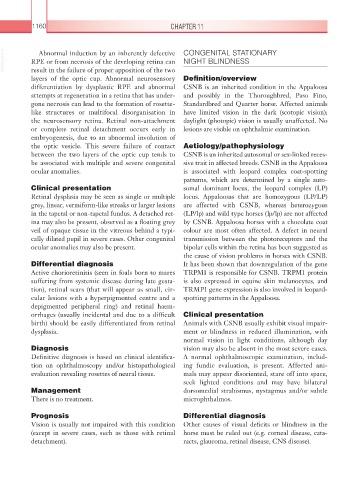Page 1185 - Equine Clinical Medicine, Surgery and Reproduction, 2nd Edition
P. 1185
1160 CHAPTER 11
Abnormal induction by an inherently defective CONGENITAL STATIONARY
VetBooks.ir RPE or from necrosis of the developing retina can NIGHT BLINDNESS
result in the failure of proper apposition of the two
layers of the optic cup. Abnormal neurosensory Definition/overview
differentiation by dysplastic RPE and abnormal CSNB is an inherited condition in the Appaloosa
attempts at regeneration in a retina that has under- and possibly in the Thoroughbred, Paso Fino,
gone necrosis can lead to the formation of rosette- Standardbred and Quarter horse. Affected animals
like structures or multifocal disorganisation in have limited vision in the dark (scotopic vision);
the neurosensory retina. Retinal non-attachment daylight (photopic) vision is usually unaffected. No
or complete retinal detachment occurs early in lesions are visible on ophthalmic examination.
embryogenesis, due to an abnormal involution of
the optic vesicle. This severe failure of contact Aetiology/pathophysiology
between the two layers of the optic cup tends to CSNB is an inherited autosomal or sex-linked reces-
be associated with multiple and severe congenital sive trait in affected breeds. CSNB in the Appaloosa
ocular anomalies. is associated with leopard complex coat-spotting
patterns, which are determined by a single auto-
Clinical presentation somal dominant locus, the leopard complex (LP)
Retinal dysplasia may be seen as single or multiple locus. Appaloosas that are homozygous (LP/LP)
grey, linear, vermiform-like streaks or larger lesions are affected with CSNB, whereas heterozygous
in the tapetal or non-tapetal fundus. A detached ret- (LP/lp) and wild type horses (lp/lp) are not affected
ina may also be present, observed as a floating grey by CSNB. Appaloosa horses with a chocolate coat
veil of opaque tissue in the vitreous behind a typi- colour are most often affected. A defect in neural
cally dilated pupil in severe cases. Other congenital transmission between the photoreceptors and the
ocular anomalies may also be present. bipolar cells within the retina has been suggested as
the cause of vision problems in horses with CSNB.
Differential diagnosis It has been shown that downregulation of the gene
Active chorioretinitis (seen in foals born to mares TRPM1 is responsible for CSNB. TRPM1 protein
suffering from systemic disease during late gesta- is also expressed in equine skin melanocytes, and
tion), retinal scars (that will appear as small, cir- TRMP1 gene expression is also involved in leopard-
cular lesions with a hyperpigmented centre and a spotting patterns in the Appaloosa.
depigmented peripheral ring) and retinal haem-
orrhages (usually incidental and due to a difficult Clinical presentation
birth) should be easily differentiated from retinal Animals with CSNB usually exhibit visual impair-
dysplasia. ment or blindness in reduced illumination, with
normal vision in light conditions, although day
Diagnosis vision may also be absent in the most severe cases.
Definitive diagnosis is based on clinical identifica- A normal ophthalmoscopic examination, includ-
tion on ophthalmoscopy and/or histopathological ing fundic evaluation, is present. Affected ani-
evaluation revealing rosettes of neural tissue. mals may appear disoriented, stare off into space,
seek lighted conditions and may have bilateral
Management dorsomedial strabismus, nystagmus and/or subtle
There is no treatment. microphthalmos.
Prognosis Differential diagnosis
Vision is usually not impaired with this condition Other causes of visual deficits or blindness in the
(except in severe cases, such as those with retinal horse must be ruled out (e.g. corneal disease, cata-
detachment). racts, glaucoma, retinal disease, CNS disease).

